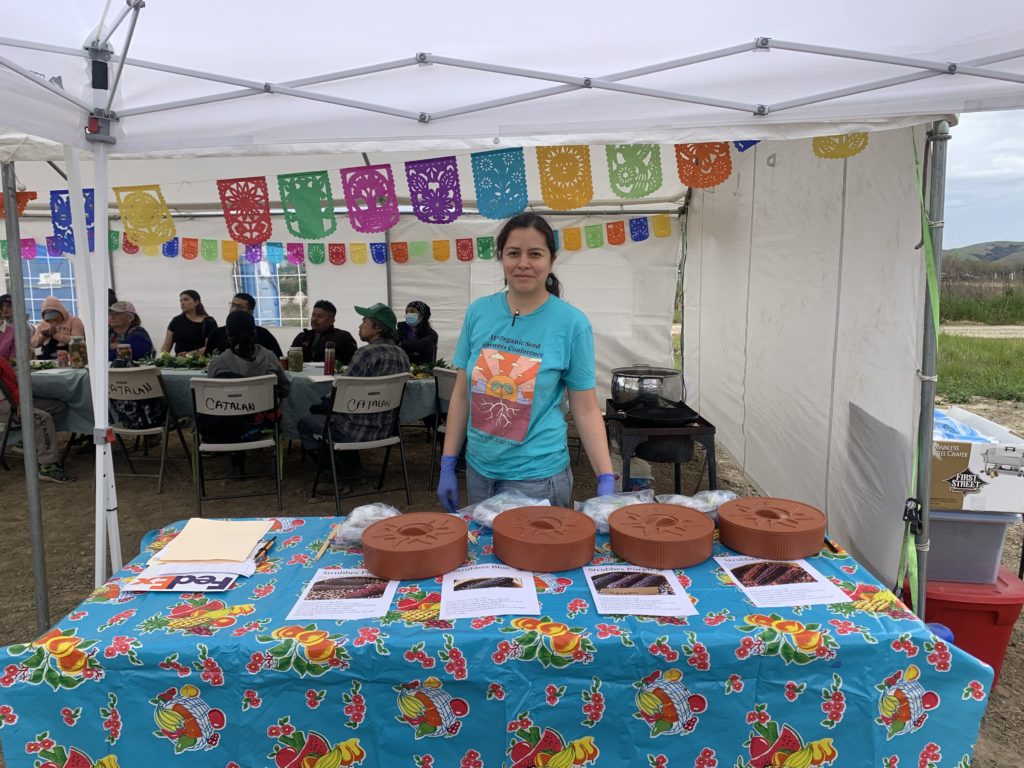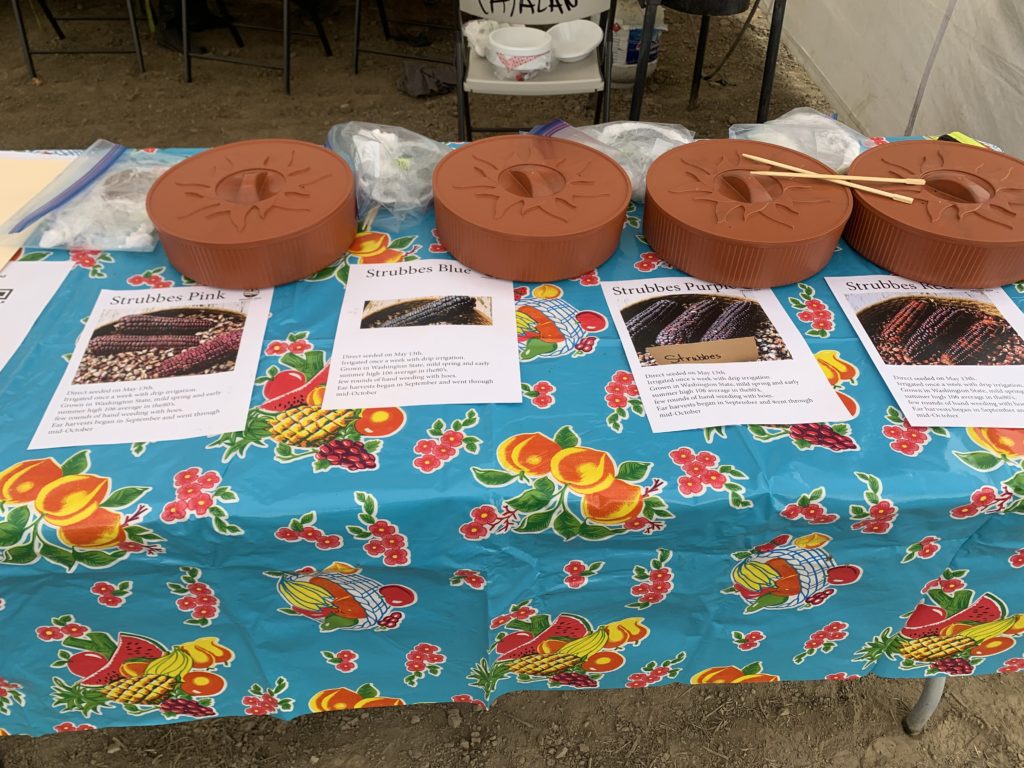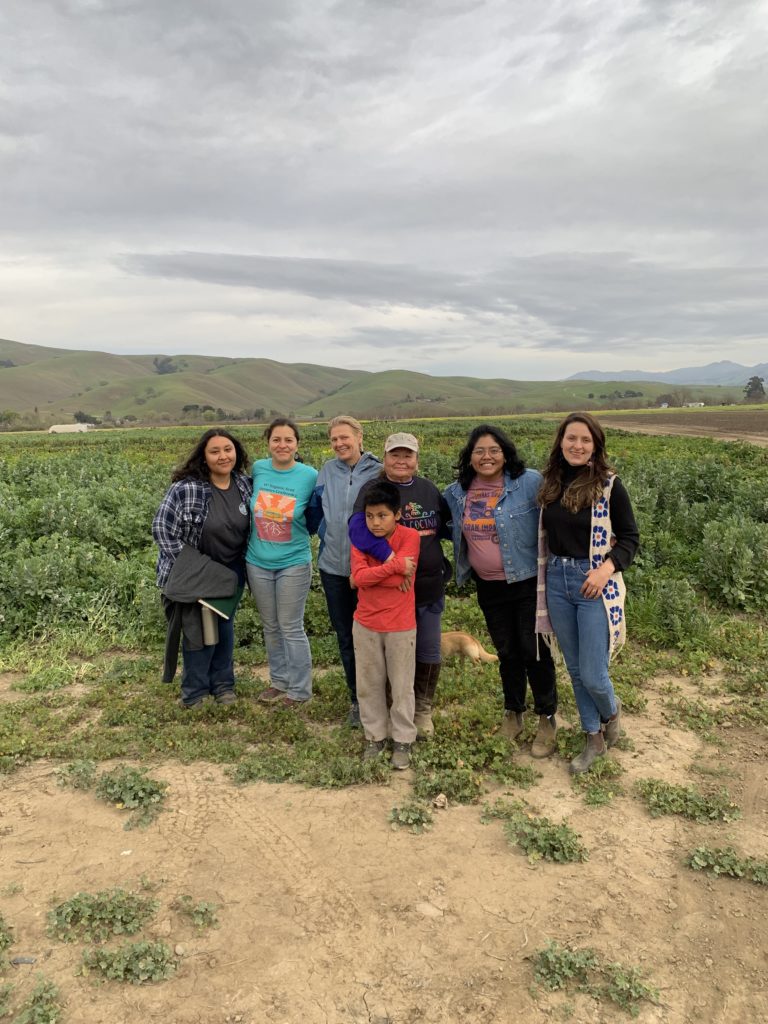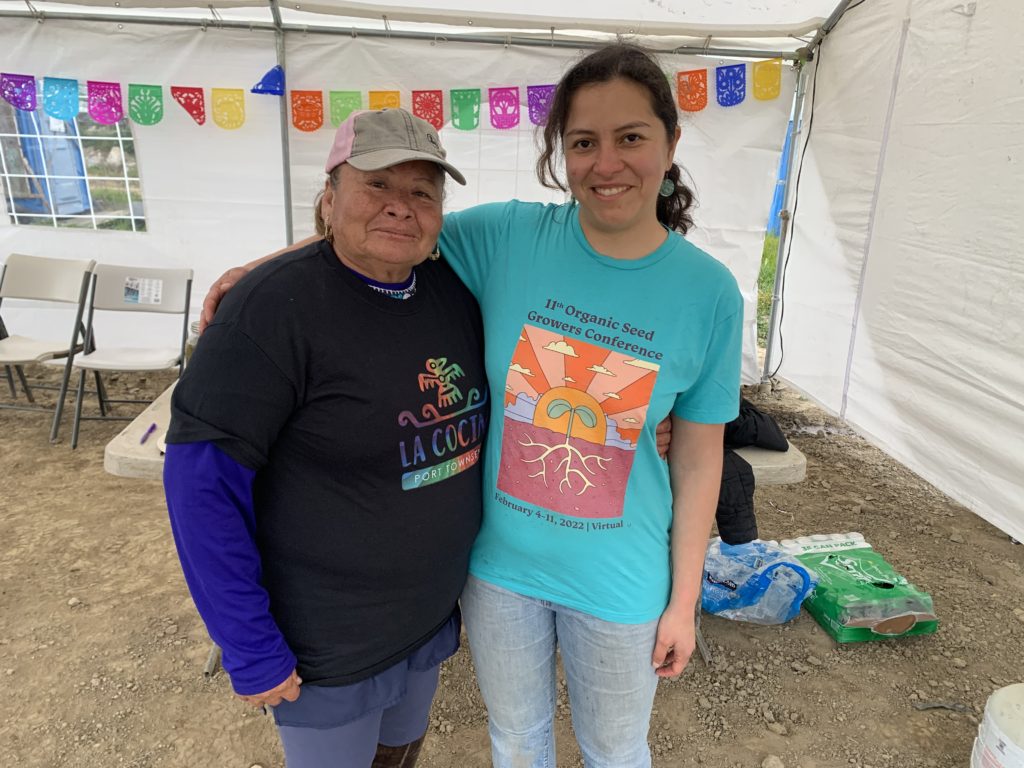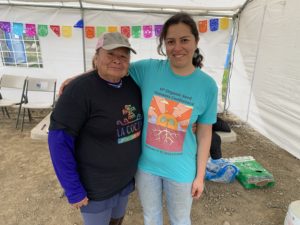
Multicolored maize is recognized for being rich in pigments such as anthocyanins, a powerful natural anticancer antioxidant (Guillen-Sánchez et. al., 2011), and also for having high contents of fiber, protein, easily digestible carbohydrates, magnesium, and vitamins (Castañeda-Sanchez, 2011). Research also suggests that the maintenance and care of the multicolor diversity of heirloom maize forms part of the cultural identity of the Indigenous peoples of southern Chiapas, center of origin and diversification of maize (Perales et. al., 2005).
Trialing Colored Maize in Washington
During the 2021 growing season, OSA’s Pacific Northwest Research Team trialed four colored maize varieties for the viability and productivity of the climatic and ecological conditions in Washington. Seeds used in the trials were bred by Ernest Strubbe and the collection names were Strubbes Pink, Strubbes Purple, Strubbes Blue, and Strubbes Red. All of the varieties were direct seeded on May 13, 2021, and harvested between the first weeks of September and mid-October, tolerating maximum temperatures of 106°F during early summer and an average of 80°F during the rest of the season. Plants were watered once a week and the only cultivation was a few rounds of hand weeding with hoes (McKenzie, personal communication).
Taste Evaluations in California
We had the opportunity to share about the project and host a taste evaluation at this year’s California Small Farmers Conference organized by the Community Alliance with Family Farmers (CAFF). OSA’s Ana Galvis-Martinez offered taste evaluations of the four Strubbes colored maize varieties to about 25 attendees at the in-person portion of the conference with the help of Liseth and Cassandra Garay, two entrepreneurs who have a gourmet Mexican food restaurant called La Cocina in Port Townsend, Washington. While tasting the warm tortillas several of the attendees exclaimed: “This does taste like a real tortilla!”
As part of the exercise, attendees evaluated the appearance, texture, and flavor of the tortillas. In terms of appearance, the evaluating group who was diverse and made up mostly of Latino farmworkers, rated the purple variety as the best looking, followed by blue, pink, and red. In terms of texture, purple maize also took first place, followed by pink, red, and blue. In terms of flavor, pink maize was rated as the tastiest, followed by purple; red and blue had similar scores (Graph 1).
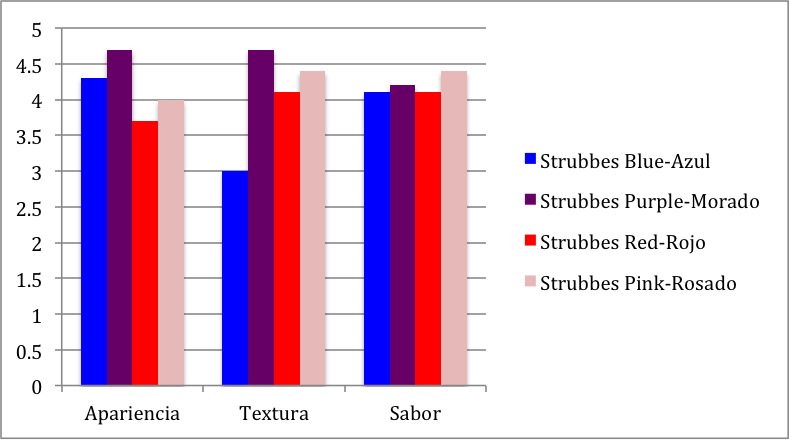
When averaging the score of all the indicators, purple corn took first place, followed by pink, red, and blue (Graph 2). Several of those attending the tasting stated, “the blue one is tasty, but it would be better for chips, the others are very good for tortillas.”
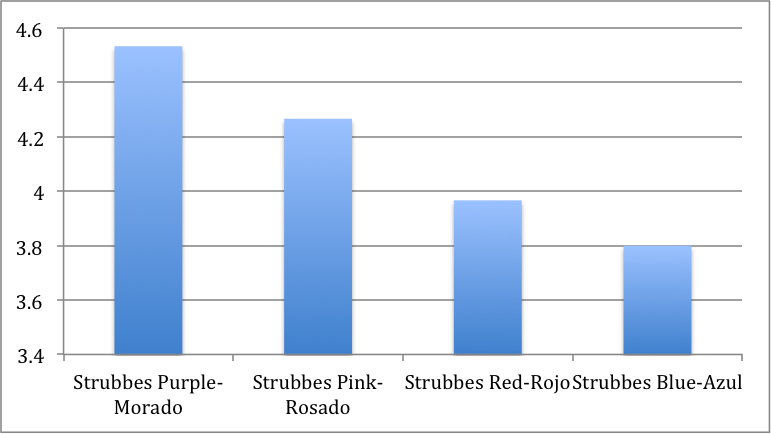
At the end of the afternoon we celebrate the special opportunity to share an activity in person, and highlighted the value of corn diversity and the importance of learning to produce organic seeds as a strategy to satisfy the needs of the organic farmers and to diversify the sources of economic income on the farm.
References
Guillén-Sánchez, J., Mory-Arismendi S., Paucar-Menacho L. 2014. Characteristics and functional properties of purple corn (Zea mays L.) var. subnigroviolaceo. Scientia Agropecuaria vol.5 no.4 Trujillo. Perú. En línea: http://www.scielo.org.pe/scielo.php?pid=S2077-99172014000400005&script=sci_arttext
Castañeda-Sánchez, 2011. Propiedades nutricionales y antioxidantes del maíz azul (Zea mays L.). Temas Selectos de Ingeniería de Alimentos 5-2 (2011) – 75 – 83. México. En línea: https://www.udlap.mx/WP/tsia/files/No5-Vol-2/TSIA-5(2)-Castaneda-Sanchez-2011.pdf
Perales, H. R., Benz, B. F., & Brush, S. B. 2005. Maize diversity and ethnolinguistic diversity in Chiapas, Mexico. Proceedings of the National Academy of Sciences, 102(3), 949-954. En línea https://www.pnas.org/doi/pdf/10.1073/pnas.0408701102
Evaluando Tortillas de Maíces de Colores: Una Experiencia Deliciosa
Los maíces de colores son reconocidos por ser ricos en pigmentos como las antocianinas, un poderoso antioxidante natural anticancerígeno (Guillen-Sánchez et. al., 2011) y también por tener altos contenidos de fibra, proteína, carbohidratos de fácil digestión, magnesio y vitaminas (Castañeda-Sánchez, 2011).
Investigación también sugiere que el mantenimiento y cuidado de la diversidad multicolor de maíces criollos hace parte de la identidad cultural de los pueblos indígenas del sur de Chiapas, centro de origen y diversificación del maíz (Perales et. al., 2005)
Prueba de maíz de color en Washington
Durante la temporada de crecimiento 2021, el personal de la Alianza por las Semillas Orgánicas (OSA), se dio a la tarea de probar la viabilidad y productividad en las condiciones climáticas y ecológicas del estado de Washington de 4 variedades de maíces de colores a partir de semillas conservadas por Ernest Strubbe, con los nombres de colección: Strubbes Pink-Rosado, Strubbes Purple-Morado, Strubbes Blue-Azul, and Strubbes Red-Rojo. Todas las variedades fueron sembradas directamente en el suelo en Mayo 13 y cosechadas entre las primeras semanas de septiembre y mediados de octubre, resistiendo temperaturas máximas de 106°F durante al inicio del verano y un promedio de 80°F durante el resto de la temporada. Las plantas fueron regadas una vez por semana y solo se hizo control manual de malezas unas pocas veces durante toda la temporada (McKenzie, comunicación personal).
Evaluaciones de sabor en California
Dentro del marco de la conferencia de pequeños agricultores de California organizada por la Community Alliance with Family Farmers (CAFF), OSA se dio a la tarea de hacer una evaluación de degustación de estas 4 variedades de maíz, y con la ayuda de, Liseth y Cassandra Garay, (dos emprendedoras que tienen un restaurante gourmet de comida mexicana llamado La Cocina en Port Townsend, Washington), se ofrecieron tortillas de cada una de las 4 variedades a cerca de 25 asistentes, mientras probaban las tortillas calientes varios de los asistentes exclamaron: Esto si sabe a tortilla!
Como parte del ejercicio se evaluó la apariencia, textura y sabor de las tortillas hechas con cada una de las variedades y estos fueron los resultados obtenidos:
En términos de apariencia el publico, muy diverso pero compuesto mayoritariamente por trabajadores agrícolas de origen latino, calificó la variedad morada como la que tiene mejor apariencia, seguida de la azul, la rosada y la roja. En términos de textura el maíz morado también se llevó el primer puesto seguido por el rosado, el rojo y el azul. En termino de sabor, el maíz rosado fue calificado como el mas sabroso, seguido por el morado; el rojo y azul tuvieron calificaciones similares (Gráfica 1).

Al promediar el puntaje de todos los indicadores el maíz morado se llevó el primer puesto, seguido por el rosado, el rojo y el azul (Gráfica 2). Varios de los asistentes a la degustación manifestaron “el azul es sabroso, pero sería mejor para chips, los demás están muy buenos para tortillas”.

Al terminar la tarde celebramos la oportunidad especial de compartir una actividad en persona, y resaltamos el valor de la diversidad de maíces y la importancia de aprender a producir semillas orgánicas como una estrategia tanto para satisfacer la necesidad propia, como por el potencial de vender a otros productores, diversificando así las fuentes de ingresos económicos en la finca.
Bibliografía
Guillén-Sánchez, J., Mory-Arismendi S., Paucar-Menacho L. 2014. Características y propiedades funcionales del maíz morado (Zea mays L.) var. Subnigroviolaceo. Scientia Agropecuaria vol.5 no.4 Trujillo. Perú. En línea: http://www.scielo.org.pe/scielo.php?pid=S2077-99172014000400005&script=sci_arttext
Castañeda-Sánchez, 2011. Propiedades nutricionales y antioxidantes del maíz azul (Zea mays L.). Temas Selectos de Ingeniería de Alimentos 5-2 (2011) – 75 – 83. México. En línea: https://www.udlap.mx/WP/tsia/files/No5-Vol-2/TSIA-5(2)-Castaneda-Sanchez-2011.pdf
Perales, H. R., Benz, B. F., & Brush, S. B. 2005. Maize diversity and ethnolinguistic diversity in Chiapas, Mexico. Proceedings of the National Academy of Sciences, 102(3), 949-954. En línea https://www.pnas.org/doi/pdf/10.1073/pnas.0408701102
